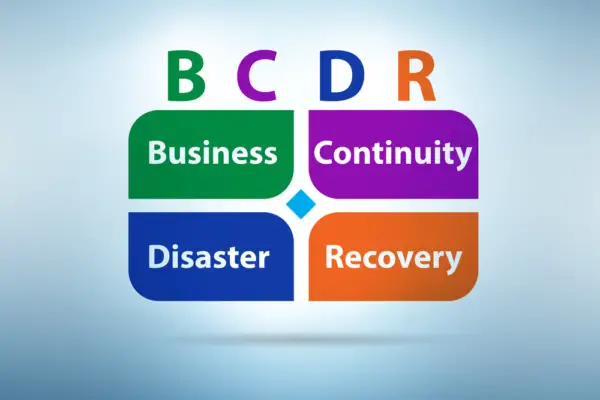A real-world example that provides a case study on lessons learned from a business continuity plan (BCP) can be found in the experiences of Puerto Rico’s manufacturers during Hurricane Maria. The National Institute of Standards and Technology (NIST) reported that having a BCP already in place was essential for the initial response to a disruptive event.
This example underscores the importance of not only having a BCP but also ensuring that it is actionable and can cover a range of scenarios that a business may face during disasters.
Moreover, the COVID-19 pandemic has provided numerous lessons for business continuity planning. For instance, it highlighted the need for businesses to be adaptable and have plans that are not overly prescriptive but flexible enough to address unforeseen challenges.
Ceridian suggests that the pandemic has been a wake-up call for many organizations to update their BCPs with considerations for widespread and prolonged disruptions.
The significance of a well-documented plan that is clearly communicated across the organization is also a key takeaway. The PULSE Network case study emphasizes the importance of creating the correct “tone at the top” and identifying emergency response and business recovery teams in advance.
These examples highlight the necessity of proactive planning, the value of an adaptable and comprehensive BCP, and the importance of clear communication and leadership in ensuring business continuity during and after a crisis.
Business continuity planning is the process of creating a strategy to ensure that an organization can continue to operate during and after a disruption. This disruption could be caused by various factors, such as natural disasters, cyberattacks, pandemics, or other unexpected events.
A business continuity plan (BCP) is a document that outlines the procedures and protocols that an organization will follow to ensure that it can continue to operate during a disruption.
A BCP typically includes information about the organization’s critical functions, the key personnel responsible for implementing the plan, and the procedures for activating and maintaining the plan.
It may also include information about communication protocols, data backup and recovery procedures, and other important aspects of the organization’s operations.

The goal of a BCP is to minimize the impact of a disruption on the organization and its stakeholders and to ensure that the organization can recover as quickly as possible.
Key Takeaways
- Business continuity planning is a process that helps organizations prepare for and respond to disruptions.
- A business continuity plan is a document that outlines the procedures and protocols that an organization will follow to ensure that it can continue to operate during a disruption.
- The goal of a BCP is to minimize the impact of a disruption on the organization and its stakeholders and to ensure that the organization can recover as quickly as possible.
Understanding Business Continuity
Defining Business Continuity and Its Importance
Business continuity is the process of creating a plan to ensure that essential business functions can continue during and after a disruption.
This can include natural disasters, cyber-attacks, or other unexpected events that can disrupt normal business operations. The goal of business continuity is to minimize the impact of a disruption on the business and its customers.
Business continuity planning is important because it helps organizations identify potential risks and develop strategies to manage them. By creating a plan, organizations can ensure they are prepared for a disruption and minimize the impact on their business.
The Role of Business Continuity in Managing Disruptions
The role of business continuity in managing disruptions is to ensure that critical business functions can continue during and after a disruption.
This can include ensuring that employees have access to the resources they need to work remotely, that essential systems are available, and that customers are able to access the products and services they need.
Business continuity planning can also help organizations prevent disruptions from occurring in the first place. By identifying potential risks and developing strategies to manage them, organizations can reduce the likelihood of a disruption occurring and minimize its impact if it does.
In summary, business continuity is an essential process for organizations to ensure they can continue operating during and after a disruption.
Organizations can minimize the impact of a disruption on their business and its customers by identifying potential risks, developing strategies to manage them, and ensuring that critical business functions can continue.
Elements of a Business Continuity Plan
A Business Continuity Plan (BCP) is a comprehensive document that outlines procedures and protocols to be followed in the event of a disaster or emergency. A BCP is critical to the survival of a business, as it ensures that essential functions can continue in the event of a disruption. A BCP typically includes the following key components:
Key Components
Risk Assessment
The first step in creating a BCP is to conduct a risk assessment. This involves identifying potential risks and hazards that could impact the business, such as natural disasters, cyber-attacks, or pandemics.
Once risks have been identified, the next step is to assess each risk’s likelihood and potential impact.
Business Impact Analysis
The next step is to conduct a business impact analysis (BIA), which involves identifying critical business processes and determining the impact that a disruption to these processes would have on the organization. The BIA helps to prioritize recovery efforts and ensure that essential functions are restored as quickly as possible.
Recovery Strategies
Recovery strategies are developed Based on the risk assessment and BIA results. These strategies outline the steps that will be taken to recover critical business processes in the event of a disruption.
Recovery strategies can include backup and recovery procedures, alternate site locations, and communication plans.
Plan Development
Once recovery strategies have been developed, the next step is to create the BCP. The BCP should be a comprehensive document that outlines procedures and protocols to be followed in the event of a disaster or emergency.
The BCP should include detailed instructions for responding to different types of disruptions and contact information for key personnel.
Testing and Maintenance
Once the BCP has been developed, testing and maintaining the plan is important. Testing helps to identify any gaps or weaknesses in the plan, while maintenance ensures that the plan remains up-to-date and relevant.
Testing and maintenance should be conducted on a regular basis to ensure that the BCP is effective in the event of a disruption.
The Planning Process
The process of creating a BCP typically involves the following steps:
- Establishing the planning team.
- Conducting a risk assessment.
- Conducting a business impact analysis.
- Developing recovery strategies.
- Developing the BCP.
- Testing and maintaining the plan.
The planning process should be collaborative, involving key stakeholders from across the organization. It is important to ensure that the BCP is reviewed and updated on a regular basis to ensure its effectiveness in the event of a disruption.
Risk Assessment and Business Impact Analysis
A crucial part of Business Continuity Planning (BCP) is identifying potential risks and conducting a Business Impact Analysis (BIA). This section will discuss assessing risks and conducting a BIA to prepare a comprehensive BCP.
Identifying Potential Risks
The first step in risk assessment is identifying potential disruptions that may affect the organization. This can be done by analyzing internal and external factors that may cause disruptions. .Internal factors can include IT system failures, power outages, or employee strikes. External factors can include natural disasters, pandemics, or cyber-attacks.
Once potential disruptions are identified, it is important to assess the likelihood of each event occurring and its impact on the organization.
This can be done by assigning a risk rating to each event based on its likelihood and impact. A risk matrix can be used to visualize the risk ratings and prioritize the events that require the most attention.
Conducting the Business Impact Analysis
The next step is to conduct a BIA to determine the critical functions and resources required to maintain operations during a disruption.
The BIA should identify the maximum tolerable period of disruption (MTPD) and the minimum business continuity objective (MBCO) for each critical function.
The BIA should also identify the resources required to maintain operations during a disruption, such as personnel, equipment, and facilities. This information can be used to develop recovery strategies and prioritize recovery efforts.
In conclusion, conducting a thorough risk assessment and BIA is essential to developing a comprehensive BCP. By identifying potential risks and critical functions, organizations can develop effective recovery strategies and minimize the impact of disruptions.
Developing Response Strategies
When developing a Business Continuity Plan (BCP), it is essential to include strategies that will help the organization respond to disruptions.
These response strategies should be designed to ensure the organization can continue operating during and after a disruption.
Crisis Management
Crisis management refers to the process of managing a crisis, such as a cyber-attack, natural disaster, or other emergency situation. It involves identifying potential crises, developing a crisis management plan, and implementing the plan when a crisis occurs.
When developing a crisis management plan, it is essential to identify the key stakeholders involved in the response. These stakeholders should include senior management, IT staff, legal counsel, and public relations staff.
The plan should also include a communication strategy that outlines how the organization will communicate with stakeholders during a crisis.
Disaster Recovery Planning
Disaster recovery planning involves developing a plan to recover critical systems and data after a disruption. The plan should include procedures for backing up data, restoring systems, and testing the recovery process.
When developing a disaster recovery plan, it is essential to identify the critical systems and data that need to be recovered first. This may include customer data, financial data, and other sensitive information. The plan should also include procedures for testing the recovery process to ensure it works when needed.
Developing response strategies is a critical component of a Business Continuity Plan. By including crisis management and disaster recovery planning in the BCP, an organization can ensure that it is prepared to respond to disruptions and continue to operate during and after a crisis.

Plan Implementation and Training
Once the business continuity plan is developed, it is essential to implement it effectively. This process involves training employees on the plan, conducting regular testing, and exercising to ensure its effectiveness.
Training Programs
Training programs are an essential part of the implementation process. Employees must be trained on the plan, their roles and responsibilities, and the procedures to follow in a disaster.
The training should be conducted regularly to ensure everyone knows the plan’s latest updates.
The training should be comprehensive and cover all aspects of the plan. It should include hands-on training, such as tabletop exercises, to help employees understand the procedures better.
The training should also be tailored to the employees’ roles, ensuring they are adequately prepared to handle their responsibilities during a disaster.
Exercising and Testing the Plan
Exercising and testing the plan is crucial to ensure its effectiveness. Regular testing helps identify any gaps in the plan, allowing for improvements.
It also helps ensure that employees are familiar with the plan and can implement it correctly in a disaster.
Various testing methods, such as tabletop exercises, functional exercises, and full-scale exercises, can be used. Tabletop exercises involve simulating a disaster scenario and discussing the plan’s response.
Functional exercises involve implementing the plan in a simulated environment. Full-scale exercises involve implementing the plan in a real-life scenario.
Regular testing and exercising of the plan ensures it is up-to-date and effective. It also helps build confidence in employees, ensuring they are prepared to handle any disaster.
In conclusion, implementing a business continuity plan requires effective training programs and regular testing and exercising. This process ensures that employees are adequately prepared to handle any disaster that may occur and the plan effectively mitigates its impact.
Case Study: Covid-19 Pandemic Response
The COVID-19 pandemic has disrupted businesses worldwide, and the need for a robust business continuity plan has become more apparent than ever.
The pandemic has forced organizations to adapt to new work-from-home models, presenting new business continuity challenges. This section will explore how some organizations responded to the COVID-19 pandemic and its impact on their business continuity plan.
Impact on Business Continuity
The COVID-19 pandemic significantly impacted business continuity, with many organizations struggling to maintain operations during the pandemic.
For example, Accenture, a global professional services company, had to adapt its business continuity plan to respond to the pandemic’s fallout. The company had to prioritize employee safety while ensuring it could continue delivering services to clients.
Adapting to Work-from-Home Models
One of the most significant challenges for organizations during the pandemic was adapting to work-from-home models. Many organizations had to quickly transition to remote work to comply with social distancing guidelines.
For example, Nissan had to implement new protocols to ensure employee safety while maintaining operations. The company had to adapt its business continuity plan to ensure it could continue operating effectively while employees worked from home.
Organizations had to invest in new technologies and tools to adapt to work-from-home models to facilitate remote work. For example, Randstad Sourceright, a global HR services company, had to implement new technologies to maintain employee engagement and business continuity during the pandemic.
The company had to invest in new communication tools, such as video conferencing software, to ensure that employees could work collaboratively while working remotely.
The COVID-19 pandemic has highlighted the need for a robust business continuity plan to adapt to new challenges. Organizations that were able to adapt quickly to new work-from-home models were able to maintain operations during the pandemic.
The pandemic has also highlighted the importance of investing in new technologies and tools to facilitate remote work.
Technology and Data Protection
Securing Technology Infrastructure
One of the key aspects of a business continuity plan is securing the technology infrastructure. This involves protecting the hardware, software, and network systems that are essential to the functioning of the organization. It is important to identify the critical systems and components that need to be secured and develop a plan to protect them.
To secure the technology infrastructure, organizations can implement a range of measures such as firewalls, intrusion detection and prevention systems, antivirus software, and regular security audits. These measures can help to prevent unauthorized access, protect against malware and other threats, and ensure that the systems are functioning as intended.
Data Backup and Recovery
Data backup and recovery is another important aspect of a business continuity plan. Organizations must ensure that their data is backed up regularly and that there is a plan in place to recover the data in the event of a disaster or system failure.
There are various methods of data backup, including full backups, incremental backups, and differential backups. It is important to choose the right backup method based on the organization’s requirements and to ensure that the data is backed up securely.
In addition to data backup, organizations must also have a plan in place for data recovery. This involves identifying the critical data that needs to be recovered first and ensuring that the necessary resources are available to recover the data quickly and efficiently.
Overall, securing technology infrastructure and data backup and recovery are crucial aspects of a business continuity plan. By implementing these measures, organizations can protect their critical systems and data, minimize downtime, and ensure that they can continue to operate even in the face of a disaster or system failure.
Compliance and Standards
Business continuity plans must adhere to legal requirements and international standards. This section will discuss how compliance and standards impact business continuity planning.
Meeting Legal Requirements
Organizations must comply with legal requirements when developing their business continuity plans. Failure to comply can lead to legal and financial consequences. Legal requirements may include data privacy laws, industry-specific regulations, and labor laws. Companies must ensure that their business continuity plans comply with these laws and regulations.
For example, the General Data Protection Regulation (GDPR) requires companies to protect personal data. Therefore, companies must ensure that their business continuity plans include measures to protect personal data during a disaster. Failure to comply with GDPR can result in fines of up to €20 million or 4% of global annual revenue, whichever is greater.

International Standards for Business Continuity
International standards provide guidelines for developing effective business continuity plans. One such standard is ISO 22301, which provides a framework for developing and implementing business continuity management systems.
Compliance with ISO 22301 can help organizations demonstrate their commitment to business continuity and improve their resilience to disruptions.
ISO 22301 requires organizations to conduct a business impact analysis, identify critical business functions, and develop strategies to ensure their continuity. The standard also requires organizations to test and review their plans regularly to ensure their effectiveness.
Adherence to international standards can help organizations improve their reputation, increase customer confidence, and reduce the risk of legal and financial consequences.
Maintaining and Reviewing the Plan
A Business Continuity Plan (BCP) is a living document that requires regular audits and updates to ensure it remains effective. In this section, we discuss the importance of regular audits and updates, as well as learning from disruptive incidents.
Regular Audits and Updates
BCPs should be audited and updated regularly to ensure that they remain relevant and effective. This process should be managed by a designated individual or team who is responsible for ensuring that the BCP is reviewed and updated at least annually.
During an audit, the BCP is reviewed to ensure that it still meets the needs of the organization. This includes reviewing the BCP’s objectives, scope, and assumptions, as well as the roles and responsibilities of those involved in the plan’s implementation.
Updates to the BCP should be made as necessary to reflect changes in the organization’s structure, processes, and systems. This includes updating contact information for key personnel, revising procedures to reflect changes in technology, and incorporating lessons learned from previous disruptive incidents.
Learning from Disruptive Incidents
Disruptive incidents can provide valuable insights into the effectiveness of a BCP. After an incident, it is essential to conduct a post-incident review to identify areas of the plan that worked well and areas that need improvement.
The post-incident review should be managed by a designated individual or team who is responsible for ensuring that the review is conducted in a timely and effective manner.
The review should include an analysis of the incident, an assessment of the BCP’s effectiveness, and recommendations for improving the plan.
Lessons learned from disruptive incidents should be incorporated into the BCP through regular updates. This ensures that the BCP remains relevant and effective in the face of new threats and challenges.
In conclusion, maintaining and reviewing a BCP is essential to ensuring its effectiveness. Regular audits and updates, as well as learning from disruptive incidents, are key components of this process.
By managing this process effectively, organizations can ensure that their BCP remains relevant and effective in the face of new threats and challenges.
Special Considerations for Small Businesses
Small businesses face unique challenges when it comes to business continuity planning. While large corporations have the resources to invest in comprehensive plans, small businesses often have limited resources and may not have the luxury of a dedicated team to focus on business continuity.
Tailoring Plans to Scale
When it comes to business continuity planning, one size does not fit all. Small businesses need to tailor their plans to their scale, resources, and unique needs.
This means that they need to identify their critical business functions and prioritize them accordingly. They also need to identify the potential risks and threats that could impact their business and develop plans to mitigate them.
Small businesses can also benefit from leveraging technology to automate their business continuity plans. This can help them save time and resources while ensuring that their plans are up-to-date and effective.
Leveraging Limited Resources
Small businesses may have limited resources, but they can still develop effective business continuity plans by leveraging their strengths. For example, small businesses can rely on their close-knit teams to coordinate their response to a crisis.
They can also leverage their relationships with local vendors and suppliers to ensure that they have the resources they need to keep their business running.
Small businesses can also benefit from collaborating with other small businesses in their community. By pooling resources and sharing knowledge, they can develop more comprehensive and effective business continuity plans.
In conclusion, small businesses face unique challenges when it comes to business continuity planning. However, by tailoring their plans to their scale and leveraging their limited resources, they can develop effective plans that help them weather any crisis.
Future Trends in Business Continuity
As technology continues to evolve and new threats emerge, businesses must keep up with the latest trends in business continuity planning to ensure they are prepared for any potential disruptions.
Two key areas of focus for future trends in business continuity are emerging threats and evolving best practices.
Emerging Threats and Technologies
As the world becomes more interconnected, businesses must be prepared for a wider range of potential threats. Cybersecurity threats, natural disasters, and supply chain disruptions are just a few examples of the types of disruptions that businesses may face in the future.
Emerging technologies such as artificial intelligence and the Internet of Things (IoT) also introduce new risks that must be taken into account.
To address these emerging threats, businesses must develop a comprehensive risk management strategy that includes regular risk assessments and ongoing monitoring of potential threats.
They must also invest in the latest technologies and tools to help them detect and respond to disruptions more quickly and effectively.

Evolving Best Practices
As businesses gain more experience with business continuity planning, best practices continue to evolve. For example, many businesses are now focusing on developing more resilient supply chains that can withstand disruptions such as natural disasters or geopolitical events.
They are also investing in more robust communication and collaboration tools to help them respond more quickly to disruptions.
To stay ahead of evolving best practices, businesses must be willing to adapt their business continuity plans on an ongoing basis. They must also be willing to invest in the latest tools and technologies to help them stay ahead of potential gaps in their planning.
Businesses must be prepared for an uncertain future by staying up-to-date with emerging threats and evolving best practices in business continuity planning.
By investing in the latest technologies and tools, and by being willing to adapt their plans on an ongoing basis, businesses can ensure they are prepared for any potential disruptions that may arise.

Chris Ekai is a Risk Management expert with over 10 years of experience in the field. He has a Master’s(MSc) degree in Risk Management from University of Portsmouth and is a CPA and Finance professional. He currently works as a Content Manager at Risk Publishing, writing about Enterprise Risk Management, Business Continuity Management and Project Management.

